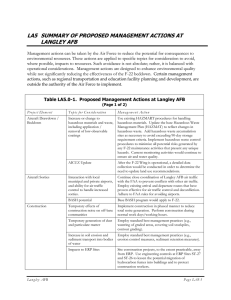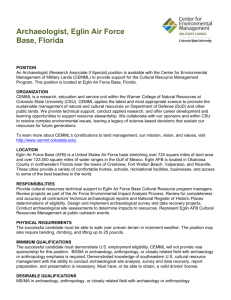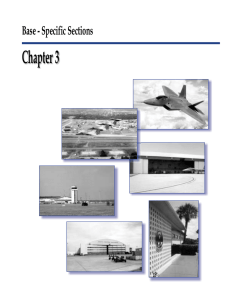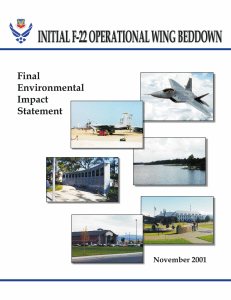EG2 EGLIN AFB ALTERNATIVE
advertisement
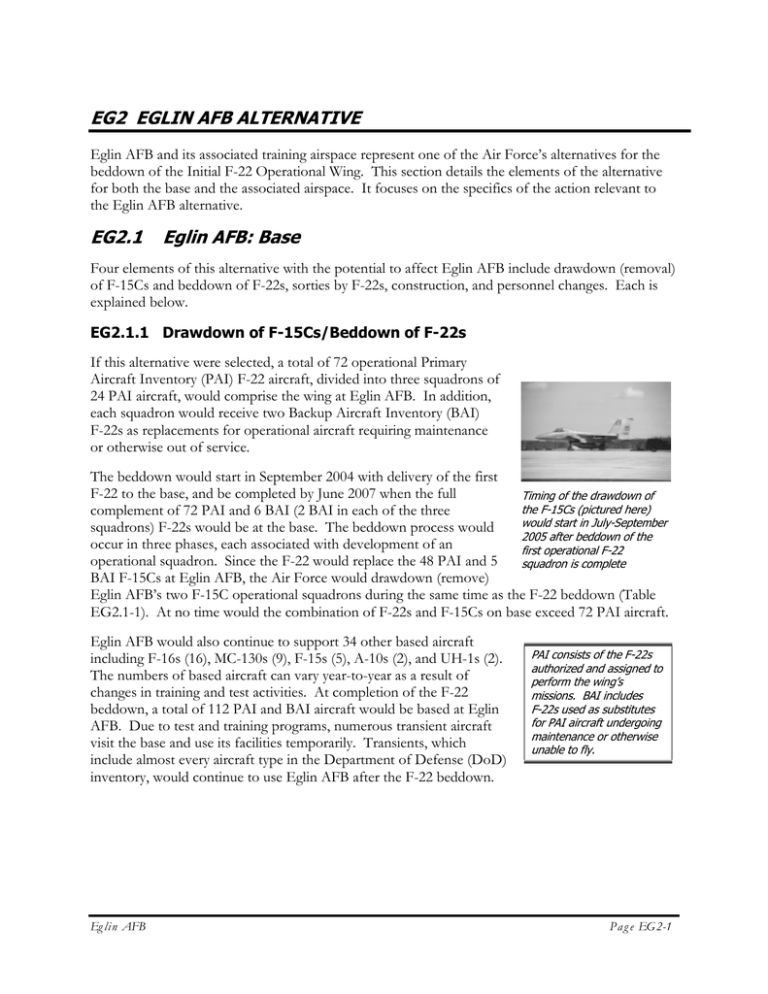
EG2 EGLIN AFB ALTERNATIVE Eglin AFB and its associated training airspace represent one of the Air Force’s alternatives for the beddown of the Initial F-22 Operational Wing. This section details the elements of the alternative for both the base and the associated airspace. It focuses on the specifics of the action relevant to the Eglin AFB alternative. EG2.1 Eglin AFB: Base Four elements of this alternative with the potential to affect Eglin AFB include drawdown (removal) of F-15Cs and beddown of F-22s, sorties by F-22s, construction, and personnel changes. Each is explained below. EG2.1.1 Drawdown of F-15Cs/Beddown of F-22s If this alternative were selected, a total of 72 operational Primary Aircraft Inventory (PAI) F-22 aircraft, divided into three squadrons of 24 PAI aircraft, would comprise the wing at Eglin AFB. In addition, each squadron would receive two Backup Aircraft Inventory (BAI) F-22s as replacements for operational aircraft requiring maintenance or otherwise out of service. The beddown would start in September 2004 with delivery of the first F-22 to the base, and be completed by June 2007 when the full Timing of the drawdown of the F-15Cs (pictured here) complement of 72 PAI and 6 BAI (2 BAI in each of the three would start in July-September squadrons) F-22s would be at the base. The beddown process would 2005 after beddown of the occur in three phases, each associated with development of an first operational F-22 operational squadron. Since the F-22 would replace the 48 PAI and 5 squadron is complete BAI F-15Cs at Eglin AFB, the Air Force would drawdown (remove) Eglin AFB’s two F-15C operational squadrons during the same time as the F-22 beddown (Table EG2.1-1). At no time would the combination of F-22s and F-15Cs on base exceed 72 PAI aircraft. Eglin AFB would also continue to support 34 other based aircraft including F-16s (16), MC-130s (9), F-15s (5), A-10s (2), and UH-1s (2). The numbers of based aircraft can vary year-to-year as a result of changes in training and test activities. At completion of the F-22 beddown, a total of 112 PAI and BAI aircraft would be based at Eglin AFB. Due to test and training programs, numerous transient aircraft visit the base and use its facilities temporarily. Transients, which include almost every aircraft type in the Department of Defense (DoD) inventory, would continue to use Eglin AFB after the F-22 beddown. Eglin AFB PAI consists of the F-22s authorized and assigned to perform the wing’s missions. BAI includes F-22s used as substitutes for PAI aircraft undergoing maintenance or otherwise unable to fly. Page EG2-1 Initial F-22 Operational Wing Beddown Draft EIS Table EG2.1-1. Proposed F-22 Beddown and F-15C Drawdown Schedule: Eglin AFB Year Based F-15C PAI Aircraft F-22 PAI Aircraft Total PAI Aircraft Baseline 48 0 48 2004 48 7 55 2005 40 32 72 2006 14 58 72 2007 0 72 72 EG2.1.2 Sorties Like existing F-15C squadrons at Eglin AFB, the operational F-22 squadrons would be integrated into the Air Force’s Expeditionary Air Force (EAF) Construct. The EAF Construct grew out of the need for the United States to deploy forces worldwide despite the reduction in United States overseas basing and personnel. Under the EAF, the Air Force has divided its forces into 10 Aerospace Expeditionary Forces (AEFs) and 2 Aerospace Expeditionary Wings (AEWs) to make worldwide deployments more predictable and manageable. An AEF is a “package” (group of different types of aircraft with a mix of capabilities suited to the tasking) deployed to overseas locations for about 90 days. These AEFs consist of wings or squadrons from multiple United States bases, and may operate as a unit or be integrated with other forces overseas. Pre- and/or postdeployment training at locations other than a “home” base also occur approximately another 30 days out of the year. Squadrons or wings at the bases are rotated into the AEF program on a 15-month cycle. Eglin AFB’s operational F-15C squadrons are part of the AEF program. The Air Force anticipates that by completion of the beddown, the Initial F-22 Operational Wing would fly 11,187 sorties per year from Eglin AFB. Based on projected requirements and deployment patterns under the AEF program, the F-22 Operational Wing would fly an additional 5,760 sorties at overseas airfields during deployments or at other locations for exercises or in preparation for deployments. On average, each squadron (24 PAI aircraft) would be deployed for 120 (90 days AEF and 30 days pre- or post-AEF training) days per year; this equates to a single squadron being deployed all year. In addition, each squadron would participate in training exercises and operate out of another United States or overseas base for an average of one week per year, flying up to another 333 sorties (or 111 sorties per squadron) at remote A sortie is the flight of a locations other than Eglin AFB. Some of these sorties could involve single aircraft from ordnance delivery training or missile firing at approved ranges such as the takeoff through landing. Nellis Range Complex in Nevada or Utah Test and Training Range. The 11,187 F-22 sorties at Eglin AFB would represent an increase of 4,275 total sorties above baseline levels (Table 2.1-2). This 16 percent increase would occur because of two factors: 24 more PAI aircraft (72 F-22s versus 48 F-15Cs) and the increased sortie rate of the F-22s (20 sorties per aircraft per month) as compared to the F-15Cs (18 sorties per aircraft per month). Page EG2-2 Eglin AFB Initial F-22 Operational Wing Beddown Draft EIS Table EG2.1-2. Comparison of Baseline F-15C and Projected F-22 Annual Sorties Baseline Sorties Projected Sorties F-15C 6,912 F-22 11,187 Total All Aircraft1 27,086 Total All Aircraft1 31,361 Note: 1. Includes 20,174 sorties by other based and transient aircraft. With the completion of the beddown, F-22s would perform about 36 percent of total sorties; F-15Cs now account for 26 percent under baseline conditions. The F-22s at Eglin AFB would employ similar departure, closed patterns, and landing procedures as currently used by the F-15Cs. F-22 operations would adhere to existing restrictions, avoidance procedures, and the quiet-hours program at Eglin AFB. However, the F-22’s power would allow it to accelerate more quickly to climb speed and throttle back its power sooner (only 2 miles past the departure end of the runway). In contrast, the F-15Cs maintain a higher power setting throughout their climb. Overall, this capability of the F-22 would result in lower noise exposure in the airfield environment as the aircraft takes off. The F-22 would fly the same percentage (30 percent) of sorties Environmental night (10:00 pm – after dark, with the rest expected to occur about one hour after 7:00 am) is the period when the sunset as required for the F-15Cs under the Air Force’s initiative effects of aircraft noise on people are accentuated. to increase readiness. Approximately 5 percent (out of the total 30 percent) of the after dark sorties are expected to occur during environmental night (10:00 pm to 7:00 am), just like for the F-15Cs. While the percentages of environmental night operations would not change with beddown of operational F-22s, the total annual sorties during this period would increase by 128 or by less than 1 per flying day (260 flying days/year). The F-15Cs at Eglin AFB currently use the afterburner to take off about 5 percent of the time. The F-22’s substantial thrust will enable it to take off using the afterburner 5 percent or less of the time. Eglin AFB encompasses approximately 463,000 acres with four other active airfields including Duke Field located approximately 10 miles north of Eglin Main. Duke Field receives negligible use (220 times per year) by Eglin AFB’s F-15Cs for rare approach pattern training or as an optional landing site. The F-22s, if based at Eglin AFB, may use Duke Field in a similar manner. Overall, use would remain negligible. Eglin AFB Page EG2-3 Initial F-22 Operational Wing Beddown Draft EIS EG2.1.3 Construction To accommodate the Initial F-22 Operational Wing, Eglin AFB must provide the necessary facilities and infrastructure (Table EG2.1-3). A total of 10 construction, modification, or infrastructure improvement projects would be implemented over the period from 2002 to 2004 (Figure EG2.1-1). Most construction would occur in 2002 and 2003. In total, the construction, modifications, and infrastructure improvements would affect about 10 acres and cost approximately $65.5 million. Construction of a new maintenance hangar, an engine shop, and a low observable composite repair facility represent the most substantial construction projects proposed at Eglin AFB. All construction and modification projects would be located along the flightline and supporting industrial area in the western portion of Eglin Main. Affected acres represent the area covered by the footprints of the proposed facilities, plus the surrounding lands where construction-related clearing and grading would occur. Much of Eglin construction would include the replacement of existing buildings such as the one pictured. Infrastructure upgrades, such as connecting new facilities to water and power systems, would also add to the affected areas on the base. Table EG2.1-3. Proposed Construction and Modification for Eglin AFB Year 2002 Description Action Low Observable Composite Repair Facility (Two Bay) Construct Affected Area In Acres 1.93 2002 Fighter Squadron Operations Construct 1.28 2002 Squadron Maintenance Facilities Upgrade NA 2003 Maintenance Hangar Construct 2.06 2003 Training Detachment Addition (Building 1363) Construct 0.18 2003 Flight Simulator Facility Construct 0.88 2004 Fighter Squadron Operations Construct 0.64 2004 Hangars-Building 1318 Upgrade NA 2004 Engine Shop Construct 1.60 2002/03/04 Associated Utilities/Infrastructure Construct 0.86 Total ≈10 Acres EG2.1.4 Personnel Changes Beddown of the Initial F-22 Operational Wing would require basing sufficient personnel to operate and maintain the wing and providing necessary support services. Overall, 1,846 personnel would be required to support the F-22 wing. For Eglin AFB, the F-22 personnel positions would be drawn from the equivalent positions associated with existing F-15C manpower authorizations. As such, total personnel would increase by 218 as a result of the additional 24 PAI F-22 aircraft (Table EG2.1-4). Page EG2-4 Eglin AFB Initial F-22 Operational Wing Beddown Draft EIS The Air Force expects that changes in personnel needed for the beddown would occur in three equal phases associated with the establishment of the three squadrons (Table EG2.1-4), starting in September 2004 and ending by June 2007. Table EG2.1-4. Proposed Personnel Changes: Eglin AFB Personnel F-22 169 1,598 791 1,846 Personnel Total 1,257 6,463 7,822 15,542 September 2006 June 2007 Personnel Total 1,215 6,347 7,762 15,324 Total Change in Personnel +42 +116 +601 +218 September 2005 – June 2006 Officer Enlisted Civilian Total Personnel F-15C 127 1,482 19 1,628 CHANGE PER BEDDOWN PHASE1 PROJECTED September 2004 – August 2005 BASELINE +14 +39 +20 +72 +14 +39 +20 +73 +14 +38 +20 +73 Note: 1. Includes 54 contractor personnel. EG2.2 Eglin AFB: Training Airspace EG2.2.1 Airspace Use As the replacement for the F-15C at Eglin AFB, the F-22 would conduct the same missions and training programs as the F-15C (refer to Chapter 2). The Air Force expects that the F-22 Operational Wing would use the airspace associated with Eglin AFB in a manner similar to how the F-15C operational squadrons currently use that airspace. All F-22 flight activities would take place in existing airspace; no airspace modifications would be required for the F-22. Scoping commentors stated that Eglin has excellent training infrastructure, airspace, and weather so more sorties can be flown. The affected airspace units for the Eglin AFB alternative include primary and occasional use airspace. Primary airspace consists of four Warning Areas (designated with a “W”) and four Military Operations Areas (MOAs) the F-22 would use on a continuing basis (Table EG2.2-1 and Figure EG2.2-1). Air Traffic Control Assigned Airspace (ATCAA) extends to at least 40,000 feet mean sea level (MSL) and overlies three of the four MOAs. Eglin AFB F-15Cs use the primary airspace for more than 99 percent of current sortie-operations. Other Air Force aircraft (F-15Cs and F-22s for advanced pilot training from Tyndall AFB, Air Force F-16s, and special operations aircraft) and the Navy (F-14s and F-18s) dominate use of these primary airspace units, especially W-151, W-453, and W-470. The F-15Cs from Eglin AFB account for about 20 percent of total sortie-operations in the eight primary airspace units. The F-22s would increase total sortie-operation use to 22 percent. The F-22s of the Initial Operational Wing would account for 17, 22, and 31 percent of the annual sortie-operations, respectively, in W-151, W-453, and W-470, the most intensively used airspace units. In W-155, the F-22s would conduct 448 sortieA sortie-operation is one use of a single airspace unit by an individual aircraft. Page EG2-6 Eglin AFB Initial F-22 Operational Wing Beddown Draft EIS operations per year, an increase of 48 total sortie operations over current Eglin F-15C use. In the four overland MOAs, F-22 use would contribute 144 cumulative additional sortie-operations, or an average increase of between 0.2 and 2.6 percent. For the MOAs, F-22s would account for 2 to 24 percent of the total sortie-operations with other aircraft flying the majority (76-98 percent) of sortieoperations. F-15C and F-22 aircraft used for advanced fighter pilot training at nearby Tyndall AFB would continue to conduct sortie-operations in W-151, W-470, Moody 3 MOA, and Tyndall LLA MOA. In W-470 and the Tyndall LLA, advanced pilot training F-15Cs and F-22s from Tyndall AFB represent the dominant users, accounting for 43 and 54 percent of the total sortie-operations, respectively. This pattern would continue with the beddown of the Initial F-22 Operational Wing. Sortie-operations by Tyndall AFB F-15Cs and F-22s contribute 12 percent or less to the total for W-151 and the Moody 3 MOA. Table EG2.2-1. Baseline and Projected Annual SortieOperations in Airspace Associated with Eglin AFB Airspace Unit Floor (Feet) Ceiling (Feet) W-151 surface unlimited W-1554 surface W-453 W-470 Moody 3 MOA Baseline Total F-15C Baseline Projected Projected Use Use F-22 Use Total Use 2,600 16,472 2,912 16,784 60,000 MSL 400 400 448 448 surface 50,000 MSL 600 2,939 672 3,011 surface unlimited 8,000 MSL3 17,935 5,824 18,599 18,000 100 5,017 112 5,029 23,000 MSL5 300 3,433 336 3,469 Camden Ridge/ Pine Hill MOAs1 500 Tyndall LLA MOA2 300 AGL 6,000-18,000 MSL 400 1,831 448 1,879 Rose Hill MOA 8,000 MSL 18,000 MSL5 400 2,293 448 2,341 Notes: 1. 2. 3. 4. 5. AGL3 5,200 MSL5 Pine Hill MOA overlies Camden Ridge MOA with a floor of 10,000 feet MSL and ceiling of 23,000 feet MSL. Tyndall C, D, and E Low-Level MOAs. MSL = mean seal level; AGL = above ground level W-155 may support unscheduled sortie-operations due to availability of Warning Areas. ATCAA overlies these MOAs. Occasional use airspace for Eglin AFB’s F-15Cs consists of the Carabelle Work Area that overlies the Tyndall E MOA (part of Tyndall LLA). Total use by these aircraft represents less than 10 sortieoperations per year. If the F-22 were based at Eglin AFB, this level of use would not measurably increase. The F-22 would fly approximately 90-minute-long missions, including takeoff, transit to and from the training airspace, training activities, and landing. Depending upon the distance and type of training activity, the F-22 would spend between 20 to 60 minutes in the training airspace. In the larger Warning Areas (W-151, W-155, and W-470), the duration of sortie-operations would be longer than in the smaller MOAs. On occasion during an exercise, the F-22 may spend up to 90 minutes in one or a set of Warning Areas. Eglin AFB Page EG2-7 Page EG2-8 Initial F-22 Operational Wing Beddown Draft EIS Eglin AFB Figure EG2.2-1 Airspace Associated with Eglin AFB Initial F-22 Operational Wing Beddown Draft EIS The F-22 would fly more of the time at higher altitudes than the F-15Cs (Table EG2.2-2). In the Warning Areas, the F-22 would fly above 5,000 feet MSL for 95 percent of the time, with 30 percent of the flight time above 30,000 feet MSL. Due to the lack of visual cues over water, fighter aircraft rarely engage in air-to-air training below 5,000 feet MSL in Warning Areas. Air Force instructions prohibit flight by F-15Cs and F-22s below 1,000 feet MSL over-water in Warning Areas. In the Moody 3 and Rose Hill MOAs, whose lower limits start at 8,000 feet MSL (about 7,600 feet above ground level [AGL), the F-22 would predominantly fly above 10,000 feet MSL (80 percent) and in the ATCAAs overlying the MOAs. General F-15 and F-22 Altitude Use % of Flight % of Flight Altitude Hours: Hours: (feet) F-15C F-22 >30,0001 8% 30% 10,000-30,000 67% 50% 5,000-10,000 14% 15% 2,000-5,000 8% 3.75% 1,000-2,000 2.75% 1% 500-1000 0.25% 0.25% The F-22 would fly about 10 percent of the time at low-altitude (500 to 5,000 feet AGL) in the Camden Ridge/Pine Hill MOA. In comparison, baseline F-15C operations at this altitude accounts for 85 percent of F-15C activity in this MOA. Most (80 Note: 1. Operations by F-22s would emphasize use of higher percent) of the flight activities by the F-22 would be altitudes more often than F-15Cs. conducted above 10,000 feet MSL (about 10,000 feet AGL) in the MOA and overlying ATCAA. In the Tyndall LLA MOA (composed of Tyndall C, D, and E MOAs), half the F-22 activity would occur below 5,000 feet AGL, as compared to 85 percent by the F-15Cs. Only 0.25 percent of the flight time by the F-22s would be from 500 to 1,000 feet AGL. This equates to about 30 minutes total flight time for the F-22s at this altitude over an entire year. Table EG2.2-2. Baseline and Projected Altitude Use in Airspace Associated with Eglin AFB Airspace Unit1 W-151 W-155 W-453 W-470 Moody 3 MOA1 Camden Ridge/Pine Hill MOA2 Tyndall LLA MOA3 Rose Hill MOA1 5001,000 0/0 0/0 0/0 0/0 NA 45/.25 PERCENT TIME OF AVERAGE SORTIE-OPERATION (FEET) F-15C/F-22 1,000 – 5,000 – 10,000 – 5,000 10,000 30,000 10/10 10/10 72/50 10/10 10/10 72/50 10/10 10/10 72/50 10/10 10/10 72/50 NA 20/20 80/50 40/9.75 10/10 5/80 45/.25 NA 40/49.75 NA 10/45 20/50 5/5 80/50 >30,000 8/30 8/30 8/30 8/30 0/30 NA Supersonic Authorized Yes Yes Yes Yes No No NA NA No No Notes: 1. MOAs base/floor is 8,000 feet MSL; ATCAA overlies MOA. 2. ATCAA overlies MOA. 3. Tyndall LLA MOA composed of Tyndall C, D, and E MOAs; ceiling/top of C and D is 6,000 feet MSL but E extends up to 18,000 feet MSL. 4. F-15Cs and F-22s will not fly below 1,000 feet MSL while over water in Warning Areas per Air Force Instructions and safety requirements. Eglin AFB Page EG2-9 Initial F-22 Operational Wing Beddown Draft EIS Environmental night (10:00 pm to 7:00 am) is the period when the effects of aircraft noise on people are accentuated. The F-22 would, on average, fly the same percent of time (30 percent) after dark as the F-15Cs currently using the airspace. Approximately 5 percent of this activity would continue to occur during environmental night. Other users of the airspace units, particularly the Warning Areas, currently fly and would continue to fly about 85 percent of night sortieoperations. To train with the full capabilities of the aircraft, the F-22 would employ supersonic flight within the Warning Areas where such activity is already authorized. No supersonic flight is authorized in the affected MOAs. Due to the F-22’s mission and its capabilities, the Air Force anticipates that approximately 25 percent of the time spent in air combat training would involve supersonic flight. Most (more than 99 percent) supersonic flight would be conducted above 10,000 feet MSL, with 60 percent occurring above 30,000 feet MSL. F-22 supersonic flight could occur infrequently (less than 1 percent) below 10,000 feet MSL in the over-water Warning Areas. In comparison, the F-15C commonly conducts air combat maneuvers in supersonic flight about 7.5 percent of the time; such flights are predominantly (84 percent) performed between 10,000 feet and 30,000 feet MSL. Within the Warning Areas, advanced fighter pilot training F-15Cs and F-22s from Tyndall AFB, Air Force F-16s, and Navy F-14 and F-18 aircraft would continue to conduct training involving supersonic flight at the same levels as under baseline conditions. No supersonic activity would occur in the occasional use airspace (Carabelle Work Area). EG2.2.2 Defensive Countermeasures Like the F-15Cs, the F-22 would employ chaff and flares as defensive countermeasures in training. Chaff and flares are mechanisms dispensed to avoid detection or attack by enemy air defense systems. Because of evolving tactics and mission scenarios, the F-22 is expected to use fewer defensive countermeasures (i.e., chaff and flares) per sortie, due to its stealth characteristics. However, because the F-22 is so new, this reduction in chaff and flare use cannot be defined yet. For the purposes of this analysis, it is estimated that the expenditure of chaff Chaff and flares are and flares by the F-22s would match that of F-15Cs on a per-sortie basis. the principal defensive Chapter 2, the overall description of the proposed action and alternatives mechanisms dispersed (section 2.1.2), provides details on the use, composition, and characteristics by military aircraft. of chaff and flares. Chaff and flares would be used in the four primary Warning Areas and in the Moody 3 MOA. Current restrictions prohibit such use in the Camden Ridge/Pine Hill, Tyndall LLA, and Rose Hill MOAs. The Carabelle Work Area, an occasional use airspace unit, also permits use of chaff and flares. No restrictions on the amount or altitude of use apply in the Warning Areas. In the Moody 3 MOA and Carabelle Work Area, standard Air Force altitude restrictions would apply (refer to Appendix AO). Under the Eglin AFB alternative, F-22s would use up to 41,951 bundles of chaff and up to 22,374 flares per year (starting in 2007). This level of use, compared to current F-15C use, represents an increase of 16,026 bundles of chaff and 8,550 flares annually. The amount of chaff Page EG2-10 Eglin AFB Initial F-22 Operational Wing Beddown Draft EIS and flares used in each airspace unit would be proportional to the number of sortie-operations conducted by the F-22s. Based on the emphasis on flight at higher altitudes for the F-22, roughly 80 percent of F-22 chaff and flare release throughout the Warning Areas and Moody 3 MOA would occur above 10,000 feet MSL. At this altitude, chaff would disperse over a wide area. Most flares would be released more than 14 times higher than the minimum altitude (700 feet) required to ensure the flares burn completely. EG2.3 Annual Chaff and Flare Use Chaff Flares F-15C 25,925 13,824 F-22 41,951 22,374 +16,026 +8,550 Change Permits and State Consultation Eglin AFB currently operates under a Title V air permit. Permits to construct and operate new stationary sources would be required for new or modified sources of regulated pollutants from engine shops, construction and operation of new Low Observable Composite Repair Facility and other structures. New construction would require compliance with the Florida Department of Environmental Protection (FDEP) stormwater rules 62-25 and 62-621 of the Florida Administrative Code. Eglin AFB would need to amend its National Pollutant Discharge Elimination System (NPDES) permit that limits the concentrations and quantities of pollutants. Because the area of construction is over five acres, permits would be required to construct and operate the facilities. The application must include proof of proper operation and maintenance of facilities, discharge monitoring, record keeping, and reporting of data to FDEP. Runoff must not create any water quality standards violations. The project could require wastewater and drinking water extension permits for new facilities in accordance with 62-550 and 62-600 of the Florida Administrative Code. Eglin AFB also consults with the Florida Department of Historic Resources (DHR) for a review for effects to resources on the National Register of Historic Places (NRHP) (or National Registereligible resources) under Section 106 of the National Historic Preservation Act (NHPA). EG2.4 Public and Agency Concerns The Environmental Impact Statement (EIS) process has undergone an extensive 8-month public scoping period, with 33 scoping meetings in five states. The Air Force publicized the scoping meetings by placing eleven meeting notices in local and regional newspapers and sending press releases to area television stations. In order to ensure maximum opportunity for community dialogue, scoping was conducted in two distinct phases. Forty-seven people attended the Phase-One and Phase-Two scoping meetings for Eglin AFB. The Phase-One scoping meeting was held in Fort Walton Beach, Florida, on April 3, 2000. The Phase-Two scoping meetings were in Niceville on July 12 and Navarre on July 13, 2000. Twenty-two written comments were received from the public and agencies prior to close of the scoping period. Eglin AFB Page EG2-11 Initial F-22 Operational Wing Beddown Draft EIS During the scoping meetings, people were given the opportunity to ask questions and provide comments on the Initial F-22 Operational Wing beddown proposal. Some of the public questions and observations include: • Are you talking about using the bombing ranges behind the bay for this fighter? (these ranges will not be used) • Are there plans for testing at other bases? (yes, testing is occurring at Edwards and Nellis AFBs) • Why is the initial beddown important to the Air Force? (see Chapter 1) • What has made Langley the preferred alternative? (see Chapters 1 and 2) • Is there any impact difference between the F-22 and the F-15C (e.g., noise, etc.)? (see section EG3.2) • Is there any hydrazine? (the F-22 does not use hydrazine) • Are there any noise effects on porpoise? (see section EG3.9 and Appendix NR-4) • Is the F-22 the same size as the F-15? (the F-22 is approximately the same size as the F-15C) • Will the Air Force consider construction costs in their basing decision? (environmental factors, costs, etc. are considered by decisionmakers) • How do demographics and land use projections play into the analysis? (see section EG3.12) • What types of hazardous materials are associated with the F-22? (see section EG3.17) • How many operational wings of F-22s will there be? (see Chapter 1) • Where will the F-22s conduct air-to-ground training? (see Chapter 2) • What’s the difference in noise level between the F-22 and F-15C? (see section EG3.2) • What would be the difference in personnel numbers with the F-22? (see section EG2.1.4) • If Eglin doesn’t get the F-22s, will the F-15Cs go away? (at this time, the Air Force has made no plans to remove the F-15C; that decision is beyond the scope of the EIS) • Eglin has an outstanding environmental and safety record. Is there anything about the F-22 and its materials that poses any environmental hazards? (see section EG3.17) • Is there a consideration of basing two squadrons at one place and one squadron at another? (see Chapter 2) Page EG2-12 Eglin AFB
